Earth (or, "the earth") is the only planet presently known to support life, and its natural features are the subject of many fields of scientific research. Within the solar system, it is third nearest to the sun; it is the largest terrestrial planet and the fifth largest overall. Its most prominent climatic features are its two large polar regions, two relatively narrow temperate zones, and a wide equatorial tropical to subtropical region.[4] Precipitation varies widely with location, from several metres of water per year to less than a millimetre. 71 percent of the Earth's surface is covered by salt-water oceans. The remainder consists of continents and islands, with most of the inhabited land in the Northern Hemisphere.
Earth has evolved through geological and biological processes that have left traces of the original conditions. The outer surface is divided into several gradually migrating tectonic plates, which have changed relatively quickly several times. The interior remains active, with a thick layer of molten mantle and an iron-filled core that generates a magnetic field.
The atmospheric conditions have been significantly altered from the original conditions by the presence of life-forms,[5] which create an ecological balance that stabilizes the surface conditions. Despite the wide regional variations in climate by latitude and other geographic factors, the long-term average global climate is quite stable during interglacial periods,[6] and variations of a degree or two of average global temperature have historically had major effects on the ecological balance, and on the actual geography of the Earth.[7][8]
[edit] Historical perspective
Earth is estimated to have formed 4.54 billion years ago from the solar nebula, along with the Sun and other planets.[10] The moon formed roughly 20 million years later. Initially molten, the outer layer of the planet cooled, resulting in the solid crust. Outgassing and volcanic activity produced the primordial atmosphere. Condensing water vapor, most or all of which came from ice delivered by comets, produced the oceans and other water sources.[11] The highly energetic chemistry is believed to have produced a self-replicating molecule around 4 billion years ago.[12]
Continents formed, then broke up and reformed as the surface of Earth reshaped over hundreds of millions of years, occasionally combining to make a supercontinent. Roughly 750 million years ago, the earliest known supercontinent Rodinia, began to break apart. The continents later recombined to form Pannotia which broke apart about 540 million years ago, then finally Pangaea, which broke apart about 180 million years ago.[13]
There is significant evidence, still being discussed among scientists, that a severe glacial action during the Neoproterozoic era covered much of the planet in a sheet of ice. This hypothesis has been termed the "Snowball Earth", and it is of particular interest as it precedes the Cambrian explosion in which multicellular life forms began to proliferate about 530–540 million years ago.[14]
Since the Cambrian explosion there have been five distinctly identifiable mass extinctions.[15] The last mass extinction occurred some 65 million years ago, when a meteorite collision probably triggered the extinction of the non-avian dinosaurs and other large reptiles, but spared small animals such as mammals, which then resembled shrews. Over the past 65 million years, mammalian life diversified.[16]
Several million years ago, a species of small African ape gained the ability to stand upright.[17] The subsequent advent of human life, and the development of agriculture and further civilization allowed humans to affect the Earth more rapidly than any previous life form, affecting both the nature and quantity of other organisms as well as global climate. By comparison, the oxygen catastrophe, produced by the proliferation of algae during the Siderian period, required about 300 million years to culminate.)
The present era is classified as part of a mass extinction event, the Holocene extinction event, the fastest ever to have occurred.[18][19] Some, such as E. O. Wilson of Harvard University, predict that human destruction of the biosphere could cause the extinction of one-half of all species in the next 100 years.[20] The extent of the current extinction event is still being researched, debated and calculated by biologists.[21]
[edit] Geology
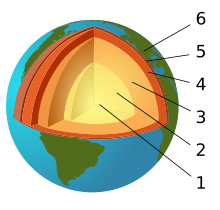

Geology is the science and study of the solid and liquid matter that constitutes the Earth. The field of geology encompasses the study of the composition, structure, physical properties, dynamics, and history of Earth materials, and the processes by which they are formed, moved, and changed. The field is a major academic discipline, and is also important for mineral and hydrocarbon extraction, knowledge about and mitigation of natural hazards, some engineering fields, and understanding past climates and environments.
[edit] Geological evolution
The geology of an area evolves through time as rock units are deposited and inserted and deformational processes change their shapes and locations.
Rock units are first emplaced either by deposition onto the surface or intrude into the overlying rock. Deposition can occur when sediments settle onto the surface of the Earth and later lithify into sedimentary rock, or when as volcanic material such as volcanic ash or lava flows, blanket the surface. Igneous intrusions such as batholiths, laccoliths, dikes, and sills, push upwards into the overlying rock, and crystallize as they intrude.
After the initial sequence of rocks has been deposited, the rock units can be deformed and/or metamorphosed. Deformation typically occurs as a result of horizontal shortening, horizontal extension, or side-to-side (strike-slip) motion. These structural regimes broadly relate to convergent boundaries, divergent boundaries, and transform boundaries, respectively, between tectonic plates.
[edit] Atmosphere, climate, and weather

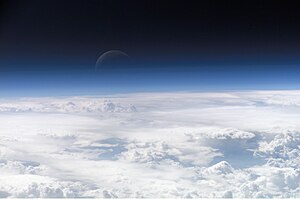
The atmosphere of the Earth serves as a key factor in sustaining the planetary ecosystem. The thin layer of gases that envelops the Earth is held in place by the planet's gravity. Dry air consists of 78% nitrogen, 21% oxygen, 1% argon and other inert gases, carbon dioxide, etc.; but air also contains a variable amount of water vapor. The atmospheric pressure declines steadily with altitude, and has a scale height of about 8 kilometres at the Earth's surface: the height at which the atmospheric pressure has declined by a factor of e (a mathematical constant equal to 2.71...).[22][23] The ozone layer of the Earth's atmosphere plays an important role in depleting the amount of ultraviolet (UV) radiation that reaches the surface. As DNA is readily damaged by UV light, this serves to protect life at the surface. The atmosphere also retains heat during the night, thereby reducing the daily temperature extremes.
Terrestrial weather occurs almost exclusively in the lower part of the atmosphere, and serves as a convective system for redistributing heat. Ocean currents are another important factor in determining climate, particularly the major underwater thermohaline circulation which distributes heat energy from the equatorial oceans to the polar regions. These currents help to moderate the differences in temperature between winter and summer in the temperate zones. Also, without the redistributions of heat energy by the ocean currents and atmosphere, the tropics would be much hotter, and the polar regions much colder.
Weather can have both beneficial and harmful effects. Extremes in weather, such as tornadoes or hurricanes and cyclones, can expend large amounts of energy along their paths, and produce devastation. Surface vegetation has evolved a dependence on the seasonal variation of the weather, and sudden changes lasting only a few years can have a dramatic effect, both on the vegetation and on the animals which depend on its growth for their food.
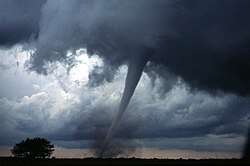
The planetary climate is a measure of the long-term trends in the weather. Various factors are known to influence the climate, including ocean currents, surface albedo, greenhouse gases, variations in the solar luminosity, and changes to the planet's orbit. Based on historical records, the Earth is known to have undergone drastic climate changes in the past, including ice ages.
The climate of a region depends on a number of factors, especially latitude. A latitudinal band of the surface with similar climatic attributes forms a climate region. There are a number of such regions, ranging from the tropical climate at the equator to the polar climate in the northern and southern extremes. Weather is also influenced by the seasons, which result from the Earth's axis being tilted relative to its orbital plane. Thus, at any given time during the summer or winter, one part of the planet is more directly exposed to the rays of the sun. This exposure alternates as the Earth revolves in its orbit. At any given time, regardless of season, the northern and southern hemispheres experience opposite seasons.
Weather is a chaotic system that is readily modified by small changes to the environment, so accurate weather forecasting is currently limited to only a few days. Overall, two things are currently happening worldwide: (1) temperature is increasing on the average; and (2) regional climates have been undergoing noticeable changes.[24]
[edit] Water on Earth

Water is a chemical substance that is composed of hydrogen and oxygen and is vital for all known forms of life.[25] In typical usage, water refers only to its liquid form or state, but the substance also has a solid state, ice, and a gaseous state, water vapor or steam. Water covers 71% of the Earth's surface[26]. On Earth, it is found mostly in oceans and other large water bodies, with 1.6% of water below ground in aquifers and 0.001% in the air as vapor, clouds (formed of solid and liquid water particles suspended in air), and precipitation.[27] Oceans hold 97% of surface water, glaciers and polar ice caps 2.4%, and other land surface water such as rivers, lakes and ponds 0.6%. Additionally, a minute amount of the Earth's water is contained within biological bodies and manufactured products.
[edit] Oceans
| Earth's oceans (World Ocean) |
|---|
An ocean is a major body of saline water, and a principal component of the hydrosphere. Approximately 71% of the Earth's surface (an area of some 361 million square kilometers) is covered by ocean, a continuous body of water that is customarily divided into several principal oceans and smaller seas. More than half of this area is over 3,000 meters (9,800 ft) deep. Average oceanic salinity is around 35 parts per thousand (ppt) (3.5%), and nearly all seawater has a salinity in the range of 30 to 38 ppt. Though generally recognized as several 'separate' oceans, these waters comprise one global, interconnected body of salt water often referred to as the World Ocean or global ocean.[28][29] This concept of a global ocean as a continuous body of water with relatively free interchange among its parts is of fundamental importance to oceanography.[30]
The major oceanic divisions are defined in part by the continents, various archipelagos, and other criteria: these divisions are (in descending order of size) the Pacific Ocean, the Atlantic Ocean, the Indian Ocean, the Southern Ocean and the Arctic Ocean. Smaller regions of the oceans are called seas, gulfs, bays and other names. There are also salt lakes, which are smaller bodies of landlocked saltwater that are not interconnected with the World Ocean. Two notable examples of salt lakes are the Aral Sea and the Great Salt Lake.
[edit] Lakes
A lake (from Latin lacus) is a terrain feature (or physical feature), a body of liquid on the surface of a world that is localized to the bottom of basin (another type of landform or terrain feature; that is, it is not global) and moves slowly if it moves at all. On Earth, a body of water is considered a lake when it is inland, not part of the ocean, is larger and deeper than a pond, and is fed by a river.[31][32] The only world other than Earth known to harbor lakes is Titan, Saturn's largest moon, which has lakes of ethane, most likely mixed with methane. It is not known if Titan's lakes are fed by rivers, though Titan's surface is carved by numerous river beds. Natural lakes on Earth are generally found in mountainous areas, rift zones, and areas with ongoing or recent glaciation. Other lakes are found in endorheic basins or along the courses of mature rivers. In some parts of the world, there are many lakes because of chaotic drainage patterns left over from the last Ice Age. All lakes are temporary over geologic time scales, as they will slowly fill in with sediments or spill out of the basin containing them.
[edit] Ponds

A pond is a body of standing water, either natural or man-made, that is usually smaller than a lake. A wide variety of man-made bodies of water are classified as ponds, including water gardens designed for aesthetic ornamentation, fish ponds designed for commercial fish breeding, and solar ponds designed to store thermal energy. Ponds and lakes are distinguished from streams via current speed. While currents in streams are easily observed, ponds and lakes possess thermally driven microcurrents and moderate wind driven currents. These features distinguish a pond from many other aquatic terrain features, such as stream pools and tide pools.
[edit] Rivers
A river is a natural watercourse[33], usually freshwater, flowing toward an ocean, a lake, a sea or another river. In a few cases, a river simply flows into the ground or dries up completely before reaching another body of water. Small rivers may also be called by several other names, including stream, creek, brook, rivulet, and rill; there is no general rule that defines what can be called a river. Many names for small rivers are specific to geographic location; one example is Burn in Scotland and North-east England. Sometimes a river is said to be larger than a creek,[34] but this is not always the case, due to vagueness in the language.[35] A river is part of the hydrological cycle. Water within a river is generally collected from precipitation through surface runoff, groundwater recharge, springs, and the release of stored water in natural ice and snowpacks (i.e., from glaciers).
[edit] Streams
A stream is a flowing body of water with a current, confined within a bed and stream banks. In the United States a stream is classified as a watercourse less than 60 feet (18 metres) wide. Streams are important as conduits in the water cycle, instruments in groundwater recharge, and they serve as corridors for fish and wildlife migration. The biological habitat in the immediate vicinity of a stream is called a riparian zone. Given the status of the ongoing Holocene extinction, streams play an important corridor role in connecting fragmented habitats and thus in conserving biodiversity. The study of streams and waterways in general is known as surface hydrology and is a core element of environmental geography.[36]
[edit] Ecosystems
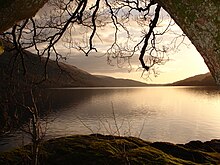
Ecosystems are composed of a variety of abiotic and biotic components that function in an interrelated way.[38] The structure and composition is determined by various environmental factors that are interrelated. Variations of these factors will initiate dynamic modifications to the ecosystem. Some of the more important components are: soil, atmosphere, radiation from the sun, water, and living organisms.
Central to the ecosystem concept is the idea that living organisms interact with every other element in their local environment. Eugene Odum, a founder of ecology, stated: "Any unit that includes all of the organisms (ie: the "community") in a given area interacting with the physical environment so that a flow of energy leads to clearly defined trophic structure, biotic diversity, and material cycles (ie: exchange of materials between living and nonliving parts) within the system is an ecosystem."[39] Within the ecosystem, species are connected and dependent upon one another in the food chain, and exchange energy and matter between themselves as well as with their environment.[40] The human ecosystem concept is grounded in the deconstruction of the human/nature dichotomy and the premise that all species are ecologically integrated with each other, as well as with the abiotic constituents of their biotope.[citation needed]
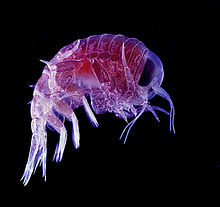
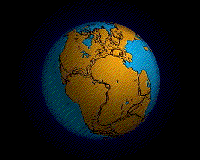





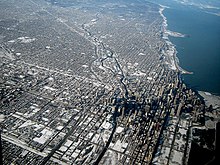
No comments:
Post a Comment